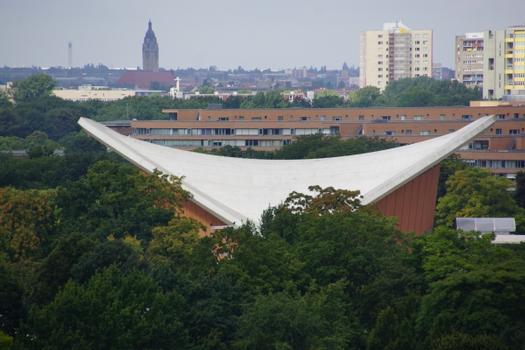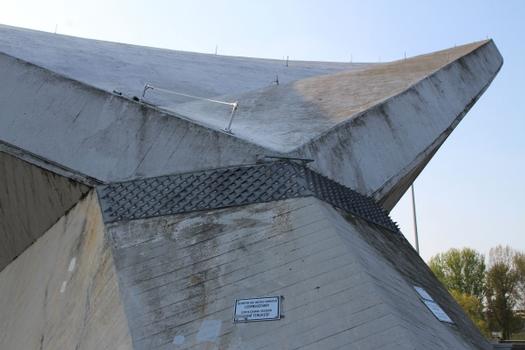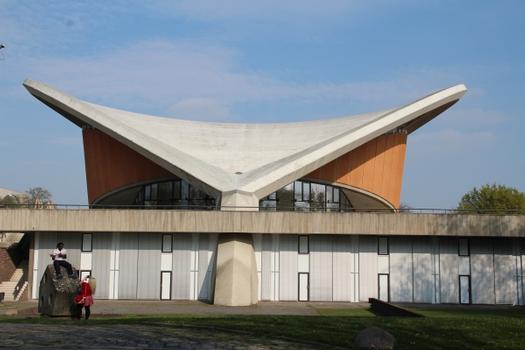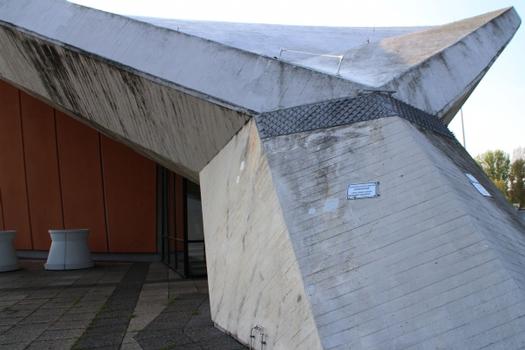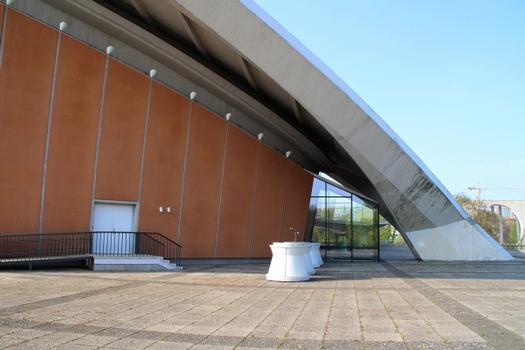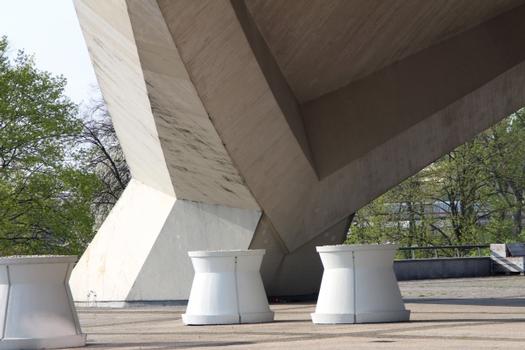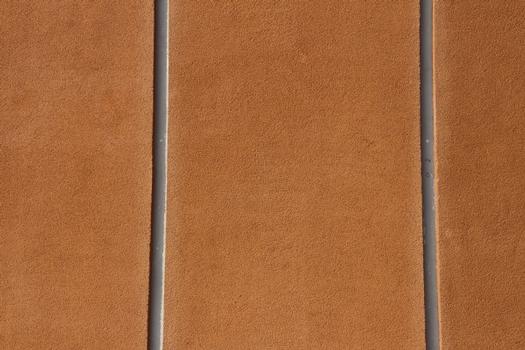General Information
| Other name(s): | Benjamin-Franklin-Halle |
|---|---|
| Completion: | 1957 |
| Status: | in use |
Project Type
| Structure: |
Thin shell |
|---|---|
| Function / usage: |
Congress center |
| Material: |
Prestressed concrete structure |
Location
| Location: |
Berlin-Tiergarten, Mitte, Berlin, Germany |
|---|---|
| Address: | John Foster-Dulles-Allee 10 |
| Coordinates: | 52° 31' 7" N 13° 21' 53" E |
Technical Information
Materials
| roof |
prestressed concrete
|
|---|---|
| arches |
reinforced concrete
|
Excerpt from Wikipedia
The Haus der Kulturen der Welt ("House of the World's Cultures", usually referred to as HKW) in Berlin is Germany's national center for the presentation and discussion of international contemporary arts, with a special focus on non-European cultures and societies. It presents art exhibitions, theater and dance performances, concerts, author readings, films and academic conferences on Visual Art and culture. It is one of the institutions which, due to their national and international standing and the quality of their work, receive funding from the federal government as so-called "lighthouses of culture", from the Federal Minister of State for Culture and the Media as well as from the Federal Foreign Office. As a venue and collaboration partner, HKW has hosted festivals such as the transmediale, curatorial platforms, biennials such as the Berlin Documentary Forum, and mentorship programs such as Forecast. Since 2013, its interdisciplinary elaboration on the Anthropocene discourse has included conferences, exhibitions, and other artistic formats performed together with philosophers, scientists, and arstists, such as Bruno Latour and Hans Joachim Schellnhuber.
Location and history
The Haus der Kulturen der Welt is located in the Tiergarten park, and directly neighbors the Carillon and the new German Chancellery. It was formerly known as the Kongresshalle conference hall, a gift from the United States, designed in 1957 by the American architect Hugh Stubbins as a part of the Interbau, an International Building Exhibition. U.S.President John F. Kennedy spoke here during his June 1963 visit to West Berlin. On May 21, 1980, the roof collapsed, killing one and injuring numerous people. The hall was rebuilt in its original style and reopened in 1987 in time for the 750-year anniversary of the founding of Berlin.
Henry Moore sculpture
Outside the entrance, Henry Moore's heaviest bronze sculpture, Large Divided Oval: Butterfly (1985–86), stands in the middle of a circular basin. Weighing nearly nine tons, it was his final major work, completed just before he died. One of three public Moore sculptures in Berlin (the others being Three Way Piece No.2: The Archer (1964–65) at the Neue Nationalgalerie and Reclining Figure (1956) at the Akademie der Künste), Butterfly was initially a loan to (then West) Berlin in 1986, but the city council wanted the sculpture permanently, and asked Moore if he would donate it. The letter arrived just before his death and went unanswered. In 1988 it was sold by the Henry Moore Foundation to Berlin for 4.5 million Deutsche Mark (around $2.58 million at the exchange rate of the day), then a huge sum for a public sculpture. The sculpture was eventually badly damaged by a combination of environmental pollution and vandalism, and restored in 2010.
Text imported from Wikipedia article "Haus der Kulturen der Welt" and modified on February 11, 2021 according to the CC-BY-SA 4.0 International license.
Participants
- Hugh Stubbins (architect)
- Fred N. Severud (engineer)
- Werner Koepcke (checking engineer)
- Hans-Peter Störl (architect)
- Wolf Rüdiger Borchardt (architect)
-
Dyckerhoff & Widmann AG
- Helmut Bomhard (structural engineer)
-
Ingenieurbüro Grassl GmbH Beratende Ingenieure Bauwesen
- Uwe Schmiedel (checking engineer)
Relevant Web Sites
Relevant Publications
- (2001): Architekturführer Berlin. 6th edition, Dietrich Reimer Verlag, Berlin (Germany), ISBN 978-3496012115, pp. 142.
- (1985): Kongresshalle Berlin-Tiergarten: eine Lösung in Stahl im Wettbewerb um den Wiederaufbau. In: Schweizer Ingenieur und Architekt, v. 103, n. 3 (17 January 1985).
- (1983): Die Kongresshalle in Berlin-Tiergarten - Schlussfolgerungen aus einem Schadensfall. In: Bautechnik, v. 60, n. 6 (June 1983), pp. 185-189.
- (1959): Kongresshalle. Berlín. In: Informes de la Construcción, v. 12, n. 107 (January 1959), pp. 57-64.
- (1982): Materialtechnische Untersuchungen am Dach der Kongresshalle in Berlin-Tiergarten. In: Bautechnik, v. 59, n. 8 (August 1982), pp. 253-260.
- About this
data sheet - Structure-ID
20009150 - Published on:
24/04/2003 - Last updated on:
16/05/2015

